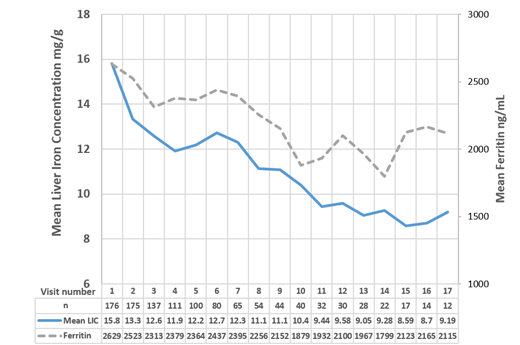
Established in 2002, the Iron Overload Program in Oakland relies on a biosusceptometer (Ferritometer®, model 5700, Tristan Technologies, San Diego, USA) utilizing low temperature SQUID technology to quantify liver iron concentration (LIC). The procedure is non-invasive and patients as young as 2 years can be been measured without sedation. The measurement and analysis are rapid (30 - 45 min) and the results have been validated against biopsy. Over 3500 measurements have been performed on 1055 patients at risk of iron overload. Longitudinal data were acquired under the natural history of iron burden by non-invasive measurement techniques study since November 2002. Patients were referred for liver iron assessment at intervals determined by their providers. Seventy-one patients had ≥10 measurements, 34 had ≥15 measurements, and 7 had ≥20 measurements. Over the course of the study, the average age at enrollment fell from 23 +/- 17 years (range 2 - 88 years) to 18 +/- 15 years (2 - 73 years). There was an increase in the proportion of patients with non-transfusion dependent thalassemia and those with iron overload from red cell transfusions associated with chemotherapy or stem cell transplantation. In comparison to the first five years (2003 - 2008) in the most recent five years (2014 - 2018) chelation has shifted from deferoxamine to deferasirox and there has been an increase in the simultaneous use of two chelators. We observed an overall decrease in mean LIC from 2400 to 1800 micrograms Fe/g liver wet weight (14.4 to 10.8 mg/g liver dry weight). Ferritin to LIC ratios were 0.46 in non-transfused thalassemia, 0.85 in intermittently transfused (< 7 mL/Kg/month), and 1.10 in transfusion-dependent (≥7 mL/Kg/month). A subgroup analysis of longitudinal data in transfusion-dependent thalassemia with multiple measurements was conducted. The mean (±s.d.) LIC decreased by 42% from 15.8 ± 10.2 at the first measurement to 9.2 ± 9.7 mg/g at the last visit. At the same time, mean ferritin decreased from 2629 to 2115 ng/mL, a change of 20%. In this group of patients ferritin levels now overestimate LIC by a significant amount (Figure). This reflects either a change in transfusion practices or the type of chelation. These results show a positive impact of oral chelators and combined chelation regimens leading to a significant improvement in iron overload in thalassemia. The development of organ complications from iron toxicity is expected to decrease, but there is a risk of over-chelation if ferritin is the sole measure of iron status. Liver biosusceptometry has been a valuable method to assess diverse conditions associated with iron overload and to monitor chelation treatment in patients across all ages.
Lal:Novartis: Research Funding; Celgene: Membership on an entity's Board of Directors or advisory committees, Research Funding; Terumo Corporation: Research Funding; Insight Magnetics: Research Funding; bluebird bio: Research Funding; Protagonist Therapeutics: Membership on an entity's Board of Directors or advisory committees, Research Funding; La Jolla Pharmaceutical Company: Research Funding. Vichinsky:Pfizer: Research Funding; Global Blood Therapeutics: Consultancy; Agios: Research Funding.
Author notes
Asterisk with author names denotes non-ASH members.

This icon denotes a clinically relevant abstract


This feature is available to Subscribers Only
Sign In or Create an Account Close Modal